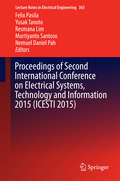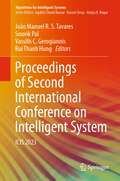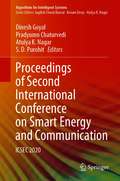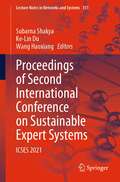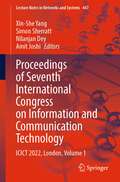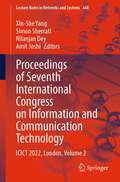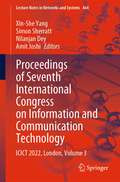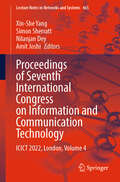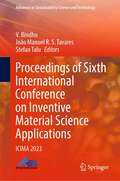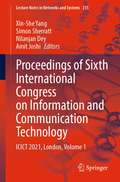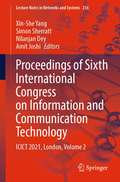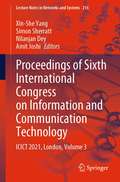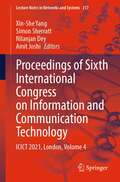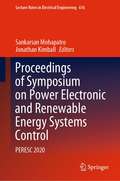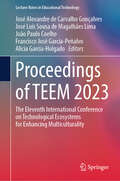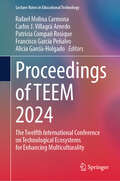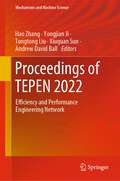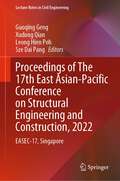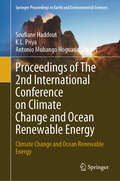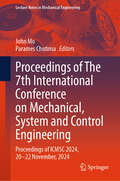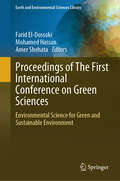- Table View
- List View
Proceedings of Second International Conference on Electrical Systems, Technology and Information 2015 (ICESTI #2015)
by Felix Pasila Yusak Tanoto Resmana Lim Murtiyanto Santoso Nemuel Daniel PahThis book includes the original, peer-reviewed research papers from the 2nd International Conference on Electrical Systems, Technology and Information (ICESTI 2015), held in September 2015 at Patra Jasa Resort & Villas Bali, Indonesia. Topics covered include: Mechatronics and Robotics, Circuits and Systems, Power and Energy Systems, Control and Industrial Automation, and Information Theory. It explores emerging technologies and their application in a broad range of engineering disciplines, including communication technologies and smart grids. It examines hybrid intelligent and knowledge-based control, embedded systems, and machine learning. It also presents emerging research and recent application in green energy system and storage. It discusses the role of electrical engineering in biomedical, industrial and mechanical systems, as well as multimedia systems and applications, computer vision and image and signal processing. The primary objective of this series is to provide references for dissemination and discussion of the above topics. This volume is unique in that it includes work related to hybrid intelligent control and its applications. Engineers and researchers as well as teachers from academia and professionals in industry and government will gain valuable insights into interdisciplinary solutions in the field of emerging electrical technologies and its applications.
Proceedings of Second International Conference on Intelligent System: ICIS 2023 (Algorithms for Intelligent Systems #21)
by João Manuel R. S. Tavares Souvik Pal Bui Thanh Hung Vassilis C. GerogiannisThis book gathers selected high-quality research papers presented at the Second International Conference on Intelligent System (ICIS 2023), organized by Industrial University of Ho Chi Minh City, Vietnam during September 29–30, 2023. It discusses high-quality and cutting-edge research in the areas of informatics, intelligent systems, and smart technologies and applications. The book is a collection of the latest research articles in intelligent control, artificial intelligence, neural networks, knowledge discovery, decision support systems, soft computing, data mining, and ontologies, machine learning, intelligent measurement, and other related fields.
Proceedings of Second International Conference on Smart Energy and Communication: ICSEC 2020 (Algorithms for Intelligent Systems)
by Atulya K. Nagar Dinesh Goyal Pradyumn Chaturvedi S. D. PurohitThis book gathers selected papers presented at the 2nd International Conference on Smart Energy and Communication (ICSEC 2020), held at Poornima Institute of Engineering and Technology, Jaipur, India, on March 20–21, 2020. It covers a range of topics in electronics and communication engineering and electrical engineering, including analog circuit design, image processing, wireless and microwave communication, optoelectronics and photonic devices, nano-electronics, renewable energy, smart grid, power systems and industry applications.
Proceedings of Second International Conference on Sustainable Expert Systems: ICSES 2021 (Lecture Notes in Networks and Systems #351)
by Ke-Lin Du Subarna Shakya Wang HaoxiangThis book features high-quality research papers presented at the 2nd International Conference on Sustainable Expert Systems (ICSES 2021), held in Nepal during September 17–18, 2021. The book focusses on the research information related to artificial intelligence, sustainability, and expert systems applied in almost all the areas of industries, government sectors, and educational institutions worldwide. The main thrust of the book is to publish the conference papers that deal with the design, implementation, development, testing, and management of intelligent and sustainable expert systems and also to provide both theoretical and practical guidelines for the deployment of these systems.
Proceedings of Seventh International Congress on Information and Communication Technology: ICICT 2022, London, Volume 1 (Lecture Notes in Networks and Systems #447)
by Xin-She Yang Nilanjan Dey Amit Joshi Simon SherrattThis book gathers selected high-quality research papers presented at the Seventh International Congress on Information and Communication Technology, held at Brunel University, London, on February 21–24, 2022. It discusses emerging topics pertaining to information and communication technology (ICT) for managerial applications, e-governance, e-agriculture, e-education and computing technologies, the Internet of Things (IoT) and e-mining. Written by respected experts and researchers working on ICT, the book offers a valuable asset for young researchers involved in advanced studies. The work is presented in four volumes.
Proceedings of Seventh International Congress on Information and Communication Technology: ICICT 2022, London, Volume 2 (Lecture Notes in Networks and Systems #448)
by Xin-She Yang Nilanjan Dey Amit Joshi Simon SherrattThis book gathers selected high-quality research papers presented at the Seventh International Congress on Information and Communication Technology, held at Brunel University, London, on February 21–24, 2022. It discusses emerging topics pertaining to information and communication technology (ICT) for managerial applications, e-governance, e-agriculture, e-education and computing technologies, the Internet of Things (IoT) and e-mining. Written by respected experts and researchers working on ICT, the book offers a valuable asset for young researchers involved in advanced studies. The work is presented in four volumes.
Proceedings of Seventh International Congress on Information and Communication Technology: ICICT 2022, London, Volume 3 (Lecture Notes in Networks and Systems #464)
by Xin-She Yang Nilanjan Dey Amit Joshi Simon SherrattThis book gathers selected high-quality research papers presented at the Seventh International Congress on Information and Communication Technology, held at Brunel University, London, on February 21–24, 2022. It discusses emerging topics pertaining to information and communication technology (ICT) for managerial applications, e-governance, e-agriculture, e-education and computing technologies, the Internet of Things (IoT) and e-mining. Written by respected experts and researchers working on ICT, the book offers a valuable asset for young researchers involved in advanced studies. The work is presented in four volumes.
Proceedings of Seventh International Congress on Information and Communication Technology: ICICT 2022, London, Volume 4 (Lecture Notes in Networks and Systems #465)
by Xin-She Yang Nilanjan Dey Amit Joshi Simon SherrattThis book gathers selected high-quality research papers presented at the Seventh International Congress on Information and Communication Technology, held at Brunel University, London, on February 21–24, 2022. It discusses emerging topics pertaining to information and communication technology (ICT) for managerial applications, e-governance, e-agriculture, e-education and computing technologies, the Internet of Things (IoT) and e-mining. Written by respected experts and researchers working on ICT, the book offers a valuable asset for young researchers involved in advanced studies. The work is presented in four volumes.
Proceedings of Sixth International Conference on Inventive Material Science Applications: ICIMA 2023 (Advances in Sustainability Science and Technology)
by João Manuel R. S. Tavares V. Bindhu Stefan TaluThe book is a collection of best selected research papers presented at the 6th International Conference on Inventive Material Science Applications (ICIMA 2023) organized by PPG Institute of Technology, Coimbatore, India, during May 11–12, 2023. The book includes original research by material science researchers toward developing a compact and efficient functional elements and structures for micro-, nano-, and optoelectronic applications. The book covers important topics like nanomaterials and devices, optoelectronics, sustainable electronic materials, nanocomposites and nanostructures, hybrid electronic materials, medical electronics, computational material science, wearable electronic devices and models, and optical/nanosensors.
Proceedings of Sixth International Congress on Information and Communication Technology: ICICT 2021, London, Volume 1 (Lecture Notes in Networks and Systems #235)
by Xin-She Yang Nilanjan Dey Amit Joshi Simon SherrattThis book gathers selected high-quality research papers presented at the Sixth International Congress on Information and Communication Technology, held at Brunel University, London, on February 25–26, 2021. It discusses emerging topics pertaining to information and communication technology (ICT) for managerial applications, e-governance, e-agriculture, e-education and computing technologies, the Internet of things (IoT) and e-mining. Written by respected experts and researchers working on ICT, the book offers a valuable asset for young researchers involved in advanced studies. The book is presented in four volumes.
Proceedings of Sixth International Congress on Information and Communication Technology: ICICT 2021, London, Volume 2 (Lecture Notes in Networks and Systems #236)
by Xin-She Yang Nilanjan Dey Amit Joshi Simon SherrattThis book gathers selected high-quality research papers presented at the Sixth International Congress on Information and Communication Technology, held at Brunel University, London, on February 25–26, 2021. It discusses emerging topics pertaining to information and communication technology (ICT) for managerial applications, e-governance, e-agriculture, e-education and computing technologies, the Internet of things (IoT) and e-mining. Written by respected experts and researchers working on ICT, the book offers a valuable asset for young researchers involved in advanced studies. The book is presented in four volumes.
Proceedings of Sixth International Congress on Information and Communication Technology: ICICT 2021, London, Volume 3 (Lecture Notes in Networks and Systems #216)
by Xin-She Yang Nilanjan Dey Amit Joshi Simon SherrattThis book gathers selected high-quality research papers presented at the Sixth International Congress on Information and Communication Technology, held at Brunel University, London, on February 25–26, 2021. It discusses emerging topics pertaining to information and communication technology (ICT) for managerial applications, e-governance, e-agriculture, e-education and computing technologies, the Internet of things (IoT) and e-mining. Written by respected experts and researchers working on ICT, the book offers a valuable asset for young researchers involved in advanced studies. The book is presented in four volumes.
Proceedings of Sixth International Congress on Information and Communication Technology: ICICT 2021, London, Volume 4 (Lecture Notes in Networks and Systems #217)
by Xin-She Yang Nilanjan Dey Amit Joshi Simon SherrattThis book gathers selected high-quality research papers presented at the Sixth International Congress on Information and Communication Technology, held at Brunel University, London, on February 25–26, 2021. It discusses emerging topics pertaining to information and communication technology (ICT) for managerial applications, e-governance, e-agriculture, e-education and computing technologies, the Internet of Things (IoT) and e-mining. Written by respected experts and researchers working on ICT, the book offers a valuable asset for young researchers involved in advanced studies. The book is presented in four volumes.
Proceedings of Symposium on Power Electronic and Renewable Energy Systems Control: PERESC 2020 (Lecture Notes in Electrical Engineering #616)
by Sankarsan Mohapatro Jonathan KimballThis book includes high-quality research papers presented at Symposium on Power Electronic and Renewable Energy Systems Control (PERESC 2020), which is held at the School of Electrical Sciences, IIT Bhubaneswar, Odisha, India, during 4–5 December 2020. The book covers original work in power electronics which has greatly enabled integration of renewable and distributed energy systems, control of electric machine drives, high voltage system control and operation. The book is highly useful for academicians, engineers, researchers and students to be familiar with the latest state of the art in power electronics technology and its applications.
Proceedings of TEEM 2023: The Eleventh International Conference on Technological Ecosystems for Enhancing Multiculturality (Lecture Notes in Educational Technology)
by João Paulo Coelho Francisco José García-Peñalvo Alicia García-Holgado José Alexandre de Carvalho Gonçalves José Luís Sousa de Magalhães LimaThis proceedings volume presents outstanding advances, with a multidisciplinary perspective, in the technological ecosystems that support Knowledge Society building and development. With its learning technology-based focus using a transversal approach, TEEM is divided into thematic and highly cohesive tracks, each of which is oriented to a specific community of interest, including researchers, professionals and students. Informatics and Education are the central issues in the conference tracks, including broad-scope research areas, such as Educational Assessment and Orientation, Human-Computer Interaction, eLearning, Computers in Education, Communication Media and Education, Medicine and Education, Learning Analytics, Engineering Education, Robotics in Education, Mechatronics, Diversity in Education, Gamification and Games for Learning.
Proceedings of TEEM 2024: The Twelfth International Conference on Technological Ecosystems for Enhancing Multiculturality (Lecture Notes in Educational Technology)
by Alicia García-Holgado Francisco García Peñalvo Rafael Molina Carmona Carlos J. Villagrá Arnedo Patricia Compañ RosiqueThis volume comprises of the proceedings of The Twelfth International Conference on Technological Ecosystems for Enhancing Multiculturality (TEEM). It reflects outstanding advances, with a multidisciplinary perspective, in the technological ecosystems that support Knowledge Society building and development. This book covers broad-scope research areas, such as Educational Assessment and Orientation, Human-Computer Interaction, eLearning, Computers in Education, Communication Media and Education, Medicine and Education, Learning Analytics, Engineering Education, Robotics in Education, Diversity in Education, Smart Learning and Gamification, and Games for Learning. TEEM is divided into fifteen thematic and highly cohesive tracks, each of which is oriented to a specific community of interest, including researchers, professionals, and students. Additionally, the multidisciplinary approach allows cross-track interest, which enhances the value of the overall volume.
Proceedings of TEPEN 2022: Efficiency and Performance Engineering Network (Mechanisms and Machine Science #129)
by Hao Zhang Andrew David Ball Yongjian Ji Tongtong Liu Xiuquan SunThis volume gathers the latest advances, innovations and applications in the field of efficiency and performance engineering, as presented by leading international researchers and engineers at the 2022 conference of the Efficiency and Performance Engineering Network (TEPEN), held in Beijing and Baotou, China on August 18-21, 2022. Topics include vibro-acoustics monitoring, condition-based maintenance, sensing and instrumentation, machine health monitoring, maintenance auditing and organization, non-destructive testing, reliability, asset management, condition monitoring, life-cycle cost optimisation, prognostics and health management, maintenance performance measurement, manufacturing process monitoring, and robot-based monitoring and diagnostics. The contributions, which were selected through a rigorous international peer-review process, share exciting ideas that will spur novel research directions and foster new multidisciplinary collaborations.
Proceedings of The 17th East Asian-Pacific Conference on Structural Engineering and Construction, 2022: EASEC-17, Singapore (Lecture Notes in Civil Engineering #302)
by Guoqing Geng Xudong Qian Leong Hien Poh Sze Dai PangThis book presents articles from The 17th East Asian-Pacific Conference on Structural Engineering and Construction, 2022, organized by National University of Singapore. These peer-reviewed articles, authored by professional engineers, academics and researchers, highlight the recent research and developments in structural engineering and construction, embracing the theme- “Towards a Resilient and Sustainable City”. The papers presented in this proceeding provide in-depth discussions with key insights into the future research, development and engineering translation in structural engineering and construction.
Proceedings of The 2nd International Conference on Climate Change and Ocean Renewable Energy: Climate Change and Ocean Renewable Energy (Springer Proceedings in Earth and Environmental Sciences)
by Soufiane Haddout Antonio Mubango Hoguane K. L. PriyaRenewable energy is energy that is collected from renewable resources that are naturally replenished on a human timescale. It includes sources such as sunlight, tides, waves, wind, rain, and geothermal heat. According to BP's-2018 Energy Outlook (EO), renewable energy will be the fastest growing source of energy, increasing fivefold by 2040, thus providing around 14% of global primary energy at this future point in time. On the other hand, climate change is bringing about rising temperatures, which has significant negative impacts on humans and the environment, and transitioning to renewable energy sources, such as biofuels, can help meet this challenge. Transitioning to renewable energy, and reducing reliance on fossil fuels, is one way to help slow down the effects of climate change. While renewables used to be a more expensive option, new clean energy technologies are lowering costs and helping to move economies away from fossil fuels.
Proceedings of The 3rd International Conference on Climate Change and Ocean Renewable Energy: Climate Change and Ocean Renewable Energy (Springer Proceedings in Earth and Environmental Sciences)
by Joan Cecilia Casila Anupam Khajuria Saim MemonThis book promotes policy frameworks and economic models facilitating large-scale ocean renewable energy deployment. Renewable energy refers to power generated from naturally replenished resources like sunlight, wind, rain, tides, waves, and geothermal heat. These sources are abundant and sustainable on a human timescale, making them crucial in addressing global energy needs. According to BP's 2018 Energy Outlook, renewable energy is set to grow fivefold by 2040, contributing about 14% of global primary energy. This growth is pivotal as climate change, driven by rising global temperatures, poses severe risks to humans and ecosystems. The transition to renewable energy, including biofuels, offers a critical solution to mitigate these impacts. By reducing reliance on fossil fuels, we can help slow the progression of climate change. In the past, renewables were seen as costly, but advancements in clean energy technology are making them more affordable. This cost reduction is accelerating the global shift toward renewable energy, promoting sustainable economic growth, and reducing environmental harm caused by fossil fuel dependency. The future of energy lies in harnessing these renewable resources.
Proceedings of The 5th International Conference on Advances in Civil and Ecological Engineering Research: Proceedings of ACEER2023 (Lecture Notes in Civil Engineering #336)
by Chih-Huang WengThis book presents select proceedings of the 5th International Conference on Advances in Civil and Ecological Engineering Research (ACEER 2023). The book covers a wide range of topics, including construction engineering and management hydraulic and hydrologic engineering, air quality and atmospheric pollution, ecological risk assessment and management, restoration and protection of environment, water pollution and treatment, and water recourses engineering. This book also covers state-of-the-art technologies in building sustainable city, resilient buildings, and sustainable issues in relating to civil engineering. It will be useful for researchers and engineers working in the field of civil and ecological engineering.
Proceedings of The 6th International Conference on Advances in Civil and Ecological Engineering Research: Proceedings of ACEER2024 (Lecture Notes in Civil Engineering #575)
by Chih-Huang WengThis book compiles the selected papers from the 6th International Conference on Advances in Civil and Ecological Engineering Research (ACEER 2024). It encompasses various subjects, including construction engineering and management, green building, transportation engineering, earthquake engineering, geotechnical engineering, hydraulic and hydrologic engineering, environmental restoration and protection, water pollution control and treatment, water resources engineering, and waste utilization in construction. This book also delves into cutting-edge technologies to foster sustainable cities and resilient buildings and address sustainability concerns related to civil engineering. The book will be a useful reference material for researchers, practitioners, and engineers in civil and ecological engineering.
Proceedings of The 6th International Conference on Clean Energy and Electrical Systems: Proceedings of CEES 2024 (Lecture Notes in Electrical Engineering #1222)
by Hossam GaberThis book provides readers with peer-reviewed research papers presented at the 6th International Conference on Clean Energy and Electrical Systems held in Kyoto, Japan, from April 5 to 7, 2024. This proceedings mainly covers theoretical, technical, and practical methods and practices on clean energy and electrical systems. And it includes nuclear energy and "renewable energy." With the continuous growth of energy demand and the increasing awareness of environmental protection in countries around the world, it is urgent and imperative to establish a clean energy innovation research and development, promotion, and application system. The book also covers electricity, fuel, thermal, transportation, and water infrastructures and their development and deployment in different regions around the world. The book includes future development trends with analysis of lifecycle and economical models for successful implementation projects.
Proceedings of The 7th International Conference on Mechanical, System and Control Engineering: Proceedings of ICMSC 2024, 20-22 November, 2024 (Lecture Notes in Mechanical Engineering)
by John Mo Parames ChutimaThis book comprises the proceedings of the 7th International Conference on Mechanical, System, and Control Engineering 2024. The contents of this volume focus on recent technological advances in the field of system dynamics and simulation, precision mechanics, production technology, structural dynamics, nanomaterial engineering, cloud computing and services, energy engineering and management, etc. This book proves a valuable resource for those in academia and industry.
Proceedings of The First International Conference on Green Sciences: Environmental Science for Green and Sustainable Environment (Earth and Environmental Sciences Library)
by Mohamed Hassan Farid El-Dossoki Amer ShehataThis book includes recent articles with new findings in Mathematics and Computer Science, Microbiology and Biotechnology, Environmental Science and Oceanography, Physics and Physical Chemistry, Chemistry, and Biochemistry. Also, it contains some articles on the state of the art. The books shows the interaction of the different disciplines of basic sciences and their roles to achieve the green environment and sustainable development via the application of green sciences. Also, the data and information in this book include solving problems in the statistic statistical and computer analysis of many experimental data; broaden the understanding for of many environmental phenomena; broaden the understanding on of how many green synthetic materials could be achieved and examples of their application in biochemistry and microbiology fields; explain how the basic sciences can help in the sustainable development; and explain how deep learning could be used in predicting some phenomena. Additionally, the book enriches understanding of many microbiological and biochemical phenomena and provides complete instructions for many biotechnological aspects. It provides complete instructions for representative waste treatment; enriches understanding of how some biochemical compounds could be tested for representative disease management; case studies that illustrate newly developed equation equations in physics; and summarizes the latest studies in the completeness between basic sciences and climate changes.
